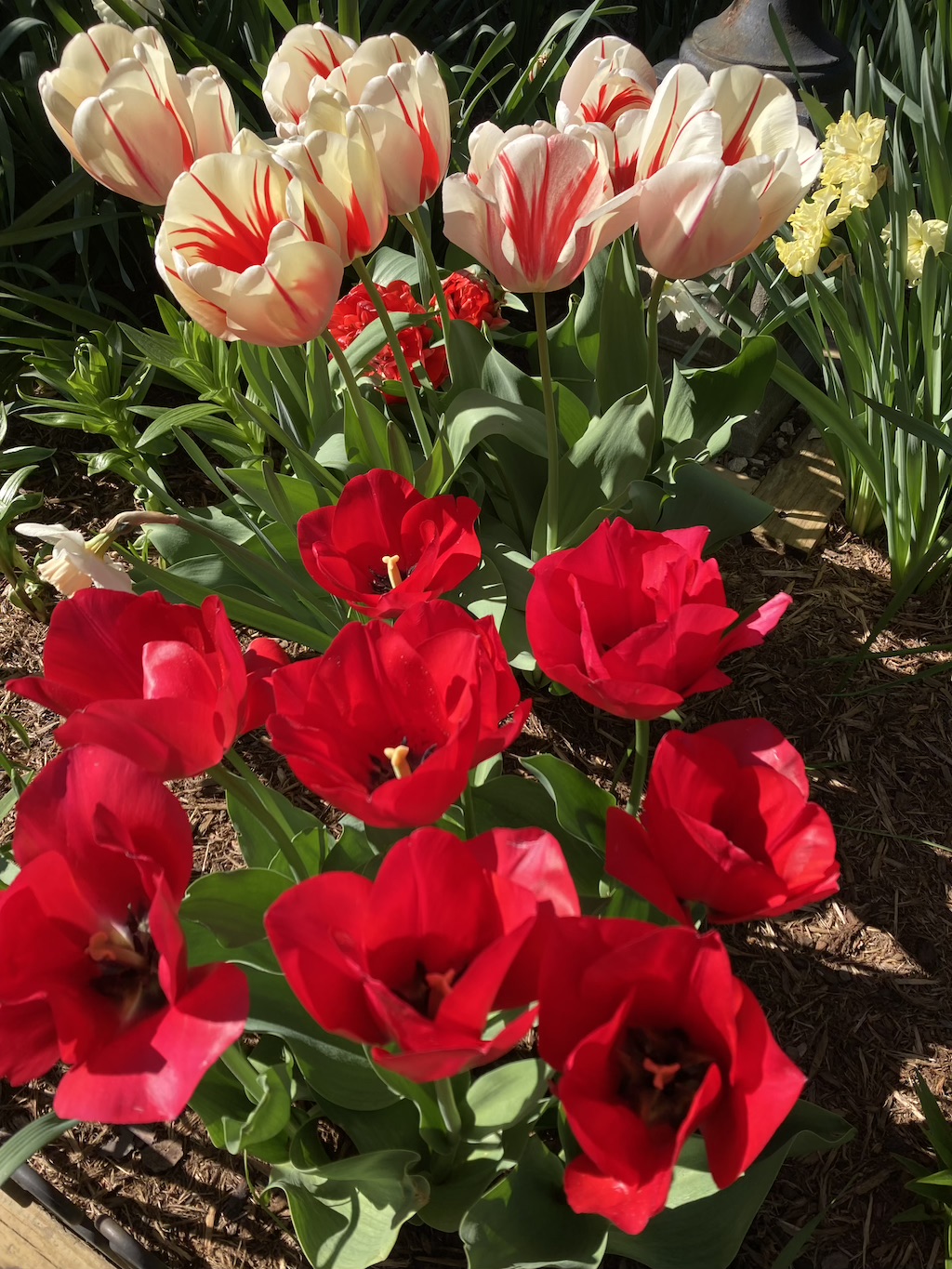
The Gardener's Domain
|
Many of you are aware of Dr. Welton’s keen interest in gardening and as the years roll by he has developed a level of expertise that he enjoys sharing with his local community. These initial 'garden musings' are articles he has written for the local Ginter Park Resident’s Association newsletter and sharing it here is another way to cultivate a passion like gardening to provide such solace and even soothe stressed out lives......at least it works for Dr. Welton!Bulbs, Bulbs, and More Bulbs!As many of you know, the Beautification Committee plants bulbs in the median of Brook Road as well as in the Chamberlayne Marker Beds so that we have wondrous displays of tulips and narcissus every spring for all to enjoy. I have made a huge emotional, physical, and economic investment in the planting of bulbs in my own garden along with planting in friends' gardens which has become my Christmas gift to them over the last many years. It takes some of my own energy to do this so it is a gift that comes with a bit of my own effort (vs. a gift card or some trinket that most of my friends do not need). The best time to plant bulbs in Richmond is starting in November and extending through the first of the year. By that point the days are cool, the soil is often wetter and bulbs will settle in better. Dry soil is not the friend of bulbs and one of the reasons tulips tend to act like annuals in this climate is that the long dry stretch from August to October dries out the bulbs and they tend to deteriorate. I often expect tulips to come back the next year in a less dramatic fashion, but after a couple years, I end up with mostly sprigs of tulip leaves that never bloom again. Narcissus, on the other hand will naturalize and sometimes grow stronger year by year. fI you want something that will persist you are much better off investing in the narcissus family. While everyone calls them "daffodils", the genus is really Narcissus, but common names are daffodils and jonquils, in addition to narcissus. There are also hyacinths, crocus, leucojum, allium, and a whole variety of Asiatic, Oriental, Trumpet and Orienpet Lillies, all of which persist and can come up year after year. If I didn't love the splash of a tulip in the spring, I would certainly give up on them as too labor intensive and not worth the long-term investment. Bulb sources are aplenty. For local sourcing, Brent and Becky's in Gloucester are widely acclaimed as a wonderful source for bulbs. There are catalogues out the wazoo so I will not mention all as you can google these on your own. My source for many years has been John Scheepers out of Bantam, Connecticut with bulbs that come from Holland (one of the preeminent bulb growing environments). Their catalogue is beautiful and has an array of tulips to include Species, Giant Darwin, Triumph, Fringes, Peony Flowering, Parrot, Greigli, Single Late, and Lily Flowering Tulips. Their collection of Narcissus is vast and they carry all the rest as well. They have a wholesale division called Van Engelen Inc. This is where I shop, buying quantities of 50 or 100 tulips and narcissus of one variety at a good discount. More exotic bulbs come in smaller "wholesale" quantities, but it is in my mind the best bargain for bulbs. They are typically shipped to Virginia in late October to early November. This ensures that you don't have bulbs sitting around getting warm, getting moldy, or deteriorating before they get in the ground. Tulips require 45 days of cold to get set for their bloom. It is why in warmer climates the bulbs are refrigerated for a time before being plucked in the ground in late winter. Narcissus and other bulbs seem to be less fussy and can be planted more flexibly. I like to plant bulbs in groupings of 13 to 15 bulbs. Because I so enjoy cutting and making bulb bouquets, I can take seven stems out of the clump and still be left with something that looks beautiful in the garden. After blooms have died in the late spring, be sure to deadhead the flowers and seed pods, but leave the green as that is what nourishes the bulb and gets it ready for next years' blooms. It is the hardest part of the whole process, as the dead foliage is not attractive and yet leaving it to die on its own is required to preserve the naturalization process. To be fair, since tulips seldom return with any gusto it seems absurd to leave the foliage in place, but I do so with rigor and hopefulness that they will return. So, the message here is that blooming bulbs are the harbinger of spring, new life, and provide such enjoyment when we really need it. If you want bulbs that will come back year after year think narcissus, allium, hyacinths, and leucojum. But if you really want to experience the grandeur of the tulip don't hesitate as sometimes the best things in life are transitory and owe their beauty to their fleeting lives here on this earth. Now is the Time to Order Your Garden SeedsWinter is the best time of year to be perusing seed catalogues and getting your order in for seeds. There are certain plants that do very well from seeds and often at considerably less expense than seedlings purchased at a garden center. Everyone has their favorites but there are so many varieties of zinnias, sunflowers, alyssum, marigolds, nasturtiums and vining flowers (hyacinth bean, moon flowers, morning glories, and cardinal flower) that can be sown directly into the soil after it really warms up. You can get a jump start by planting seeds in grow pots and place under plant lights or even in sunny windows. They even now make grow pots out of cow manure so you can pluck the seedlings into the ground and they have a built-in source of fertilizer >I am also a huge fan of various herbs that can easily be grown from seed. Basil and all its varieties are a favorite for me. There is nothing like a huge stand of basil with leaves to harvest that are an amazing compliment to Hanover tomatoes and mozzarella when the time comes in the summer. Basil requires fairly warm nights for germination, so my experience is that planting later in the spring works better. Coriander (cilantro), dill, and thyme also seem to thrive in our climate and do well. A lot of herbs really die out by August but if you let some of your herbs go to seed, they will give you a second crop by September and into the fall. I am not a vegetable garden maven so can't really give a lot of advice in that arena, but so many varieties do really well from seed. You get a lot of bang for your buck. There is something so miraculous about putting these minuscule seeds into the ground and coming forward with a huge plant that is either beautiful or productive. I love the way a nasturtium plant winds its way through the fall garden bed and provides tasty leaves and amazing flowers that add a peppery flavor to salads. Zinnias bloom way into the fall and are sometimes the last cut flowers available for that late fall bouquet. Seed sources are many and varied from your local box store to mail order catalogues such as John Scheepers Kitchen Garden Seeds (my favorite). Make sure you use fairly fresh seeds and better to buy a new packet than to use old seeds you happened to find in clean-up of your garage. Looking through seed catalogues can be an education in itself as you read about new varieties or even old standbys. The joy of seed germination can be a wondrous part of any gardener's experience and one that brings satisfaction and a sense of accomplishment to those that take the plunge. Go for it!! |
docwelton.com
last updated: April 2023
©2023DocWelton.Com

 I love it when the tulips or narcissus bloom in the spring and their long-delayed Christmas finally arrives. I preface this piece with this fact: I order somewhere between 1500 and 2000 bulbs every fall, so my perspective is perhaps jaded by the volume of my endeavor. However, I have learned a great deal about bulbs over the years.
I love it when the tulips or narcissus bloom in the spring and their long-delayed Christmas finally arrives. I preface this piece with this fact: I order somewhere between 1500 and 2000 bulbs every fall, so my perspective is perhaps jaded by the volume of my endeavor. However, I have learned a great deal about bulbs over the years.